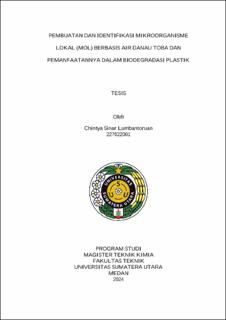| dc.description.abstract | Local Microorganisms (MOL) are fermentation solutions made from agricultural, plantation and household organic waste. MOL is made by mixing three main sources of ingredients, namely a glucose source, a complex carbohydrate source, and a microorganism source which are next fermented anaerobically. The MOL solution made can be used to reduce plastic pollution through biodegradation. This research aims to analyze the variation of the volume of Lake Toba water as a source of microorganisms in making MOL which is used to degrade plastic and to identify plastic degrading local microorganisms. The research methodology consisted of making standard curves and growth curves, making MOL, testing the biodegradation of Low-Density Polyethylene (LDPE) plastic, isolating microorganisms, performing biochemical test, testing the clear zone for plastic degrading microorganisms, and identifying microorganisms. MOL was made by mixing raw materials according to the ratio of microorganism volume to substrate namely 20:80 (% v/v); 30:70 (% v/v); and 40:60 (% v/v) which were fermented for 99 hours at temperature of 37 C. The results show that there is a change in MOL pH before and after fermentation namely from 4.75; 4.9; and 4.94. to 3.46; 3.45; and 3.48. The decrease in pH occurs due to the activity of microorganisms that produced organic acids. The three variations of MOL produce degradation percentage of LDPE plastic, namely 2.353% w/w; 3.012% w/w; and 4.023% w/w. The variation ratio of 40:60 (% v/v) shows the largest percentage of LDPE degradation, which was then isolated, and 5 isolates were obtained. Biochemical tests including starch hydrolysis test, catalase test, carbohydrate fermentation test, and Triple Sugar Iron (TSI) test were performed on the five isolates that were suspected of being able to degrade LDPE plastic. The five isolates produced positive tests in starch hydrolysis test, carbohydrate fermentation test, and TSI test. Meanwhile, in the catalase test, 2 isolates produced positive test and 3 isolates produced negative test. The five isolates were also screened to validate their potential in degrading LDPE and 2 isolates were found which produced clear zones which were identified by gram staining as Staphylococcus aureus and Streptococcus sp. | en_US |


